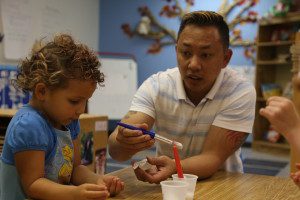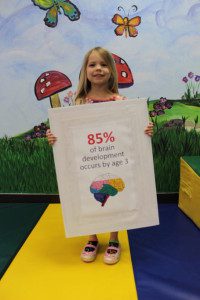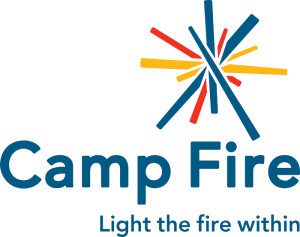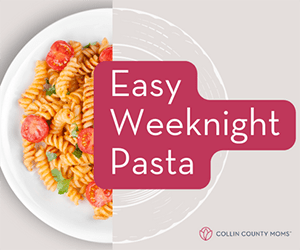Disclaimer :: This sponsored post was provided by Camp Fire First Texas as part of the Fort Worth Moms Blog “The Discipline Discussion” series.
We’ve all been there – you’re in public, and suddenly, your child enters melt-down mode. You try and try, but nothing seems to work, leaving both you and your child stressed. If it isn’t a melt-down at the grocery store, it’s uncontrollable biting habits or the end-of-the-world goodbyes at child care drop-offs or your 2 – 10-year-old resisting and fighting at bed time. While the situations may not be so simple, the explanation can be. These challenging behaviors are best described as “needs-based power struggles.” Trust us, your child doesn’t wake up thinking “I’m going to make you miserable today;” there is always a correlation between tantrum and need.
In a world where parenting styles and choices are constantly scrutinized and judged, feeling like “a failure” at parenthood is entirely too common. All too often, we feel we’ve exhausted our efforts, and there is nothing else that can be done; if only we could understand toddler and teenage language. While learning to speak “toddler” or trying to be “cool enough” to communicate with a teen might be a stretch, there is a solution. If you can’t speak their language, you have to understand how their brain works.
I know what you’re thinking – how can I understand the interworking of a human brain?
 Through a program called Conscious Discipline, parents are learning to identify their child’s brain states and make needs-based assessments on minimizing power struggles. By being able to recognize which brain state a child is in (don’t worry – there are only three), parents can take a more controlled approach to dealing with challenging behaviors.
Through a program called Conscious Discipline, parents are learning to identify their child’s brain states and make needs-based assessments on minimizing power struggles. By being able to recognize which brain state a child is in (don’t worry – there are only three), parents can take a more controlled approach to dealing with challenging behaviors.
Before we dive too far into “brain speak,” it’s important to point out the significant difference between discipline and punishment. All too often, the words are used interchangeably.
- Discipline uses dialogue and communication to teach and guide a child in a controlled and safe environment. Discipline involves recognizing the positive intent. For example, when your child takes a toy from a sibling, you state, “You wanted to play with the toy Joseph has. You didn’t know the words to ask him for it.” You then clarify the skill you want the child to use by saying, “When you want a toy Joseph has, say ‘Can I have the toy when you are done playing with it?’” You then have your child repeat the phrase back for practice, and then celebrate the action with positive words such as, “You did it!”
- Punishment reinforces fear, pain, intimidation, and/or violence for the purpose of retribution. Punishment focuses only on the incorrect action. Using the same example as above, punishment is saying, “You can’t grab the toy from Joseph! Go to time out, and think about what you’ve done,” or, “You don’t get dessert tonight.” When the consequence doesn’t make logical sense with the offense, there are no positive skills taught.
Conscious Discipline is used to help calm both child and parent. By using the Brain State Model, parents can recognize how receptive their child will be to calming tactics and make a plan of action from there.
The three states are:
- The “survival state,” which relates to the “fight, flight, or freeze” theory and is the state when a child is most vulnerable; “There are loud noises; I am tired, therefore I am not safe here.”
- The “emotional state,” which deals with the feeling of being loved; “You did not give me the candy I wanted, therefore you do not love me.”
- The “executive state,” which is the ideal state of mind for calming a child through teaching and problem solving.
Conscious Discipline teaches parents how to sooth each individual brain state differently through safety, connection, and teaching tactics. Tactics include switching from the ever-popular phrase, “Use your words,” to “Are you happy?” If a child is in the “emotional state,” they literally cannot use words to describe their emotions. Asking “Are you happy?” will lead a child to respond “yes” or “no.” From there, parents can work toward getting their child to communicate why he or she is or is not happy by calmly acknowledging a child’s emotion. “You really want that toy, and you are angry because you can’t have it.” Ideally, children will learn to operate in the “executive state” and say, “I am angry, and here is why,” before diving into the “emotional state” of a tantrum.
 Why does this even matter? Won’t my child eventually “grow out” of the tantrum phase? Conscious Discipline is more than an immediate response to a situation, but instead teaches both the parent and the child how to self-regulate their emotions – a tool that is needed well beyond childhood. Children who learn how to control their emotions and self-regulate at an early age are more likely to have more emotionally stable and successful adult lives. Children who are pushed away (a.k.a. “go to your room” or “you need to sit in time out”) are less likely to develop the necessary self-regulation and critical thinking skills at an early age.
Why does this even matter? Won’t my child eventually “grow out” of the tantrum phase? Conscious Discipline is more than an immediate response to a situation, but instead teaches both the parent and the child how to self-regulate their emotions – a tool that is needed well beyond childhood. Children who learn how to control their emotions and self-regulate at an early age are more likely to have more emotionally stable and successful adult lives. Children who are pushed away (a.k.a. “go to your room” or “you need to sit in time out”) are less likely to develop the necessary self-regulation and critical thinking skills at an early age.
We often focus on the early years of 0-3 because they are the most crucial in brain development. While the brain continues to grow daily, the next major peek in development doesn’t occur until age 10. Conscious Discipline’s approach to teaching self-regulation can be applied to all ages, from toddler to teen.
Learning Conscious Discipline methods is helpful if your child is struggling with challenging behaviors or if you just want to better understand your child and guide him or her towards self-regulation. Conscious Discipline offers new and valuable information for everyone. Camp Fire First Texas offers Conscious Discipline training multiple times a year and for the first-time ever, it is open to a new set of students: parents!
Over the course of two Saturdays, parents can receive research-based instruction and guidance from experts focusing on promoting connections and cooperation for all children at any age. Classes also include resource material and information for ongoing learning opportunities that support families. For more information, visit the Camp Fire First Texas Conscious Discipline training information site or call 817-831-2111 for more details.
 Camp Fire First Texas is one of the nation’s leading non-profit youth development organizations, serving youth, teens, and families in communities across the United States. Camp Fire programs are research-based, delivered where youth and families are via out-of-school time, environmental and camp, and teen service and leadership programs. Because youth want to shape the world, Camp Fire’s focus is giving youth and teens the opportunity to find their sparks, lift their voice, and discover who they are. Camp Fire programs are proven to develop young peoples’ skills now so they can reach their full potential. Follow Camp Fire on Facebook, Twitter, Instagram, and Pinterest.
Camp Fire First Texas is one of the nation’s leading non-profit youth development organizations, serving youth, teens, and families in communities across the United States. Camp Fire programs are research-based, delivered where youth and families are via out-of-school time, environmental and camp, and teen service and leadership programs. Because youth want to shape the world, Camp Fire’s focus is giving youth and teens the opportunity to find their sparks, lift their voice, and discover who they are. Camp Fire programs are proven to develop young peoples’ skills now so they can reach their full potential. Follow Camp Fire on Facebook, Twitter, Instagram, and Pinterest.













